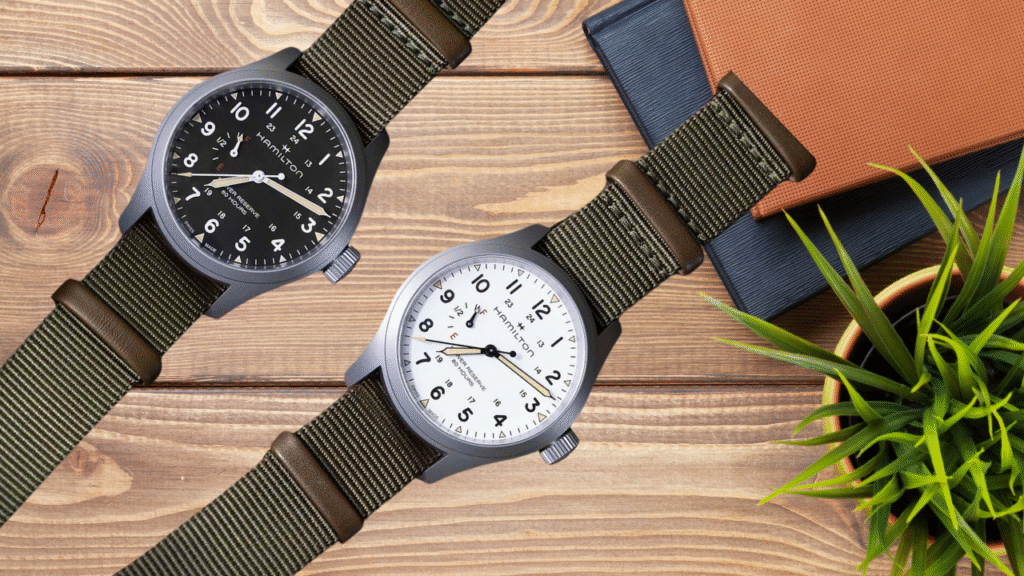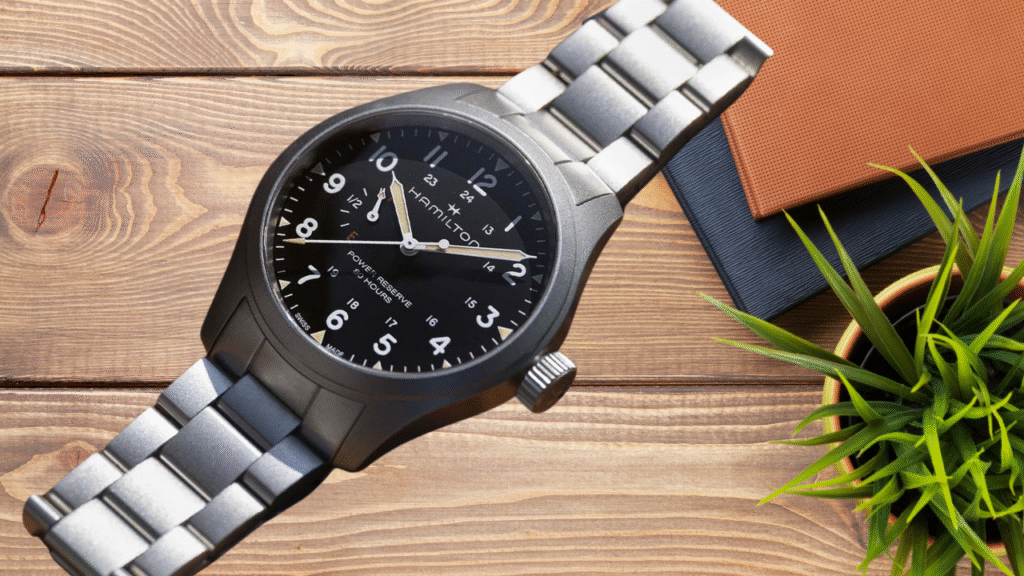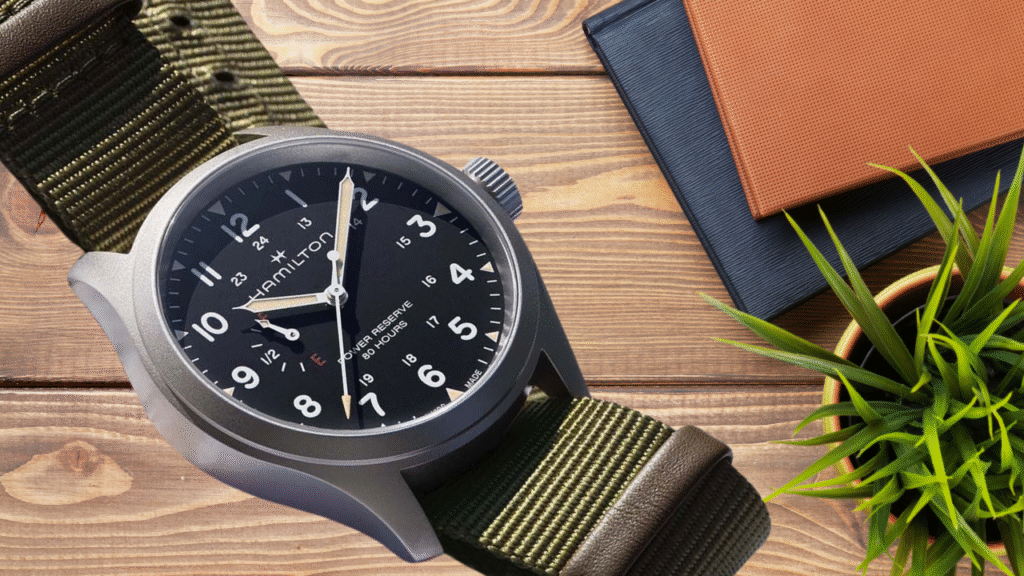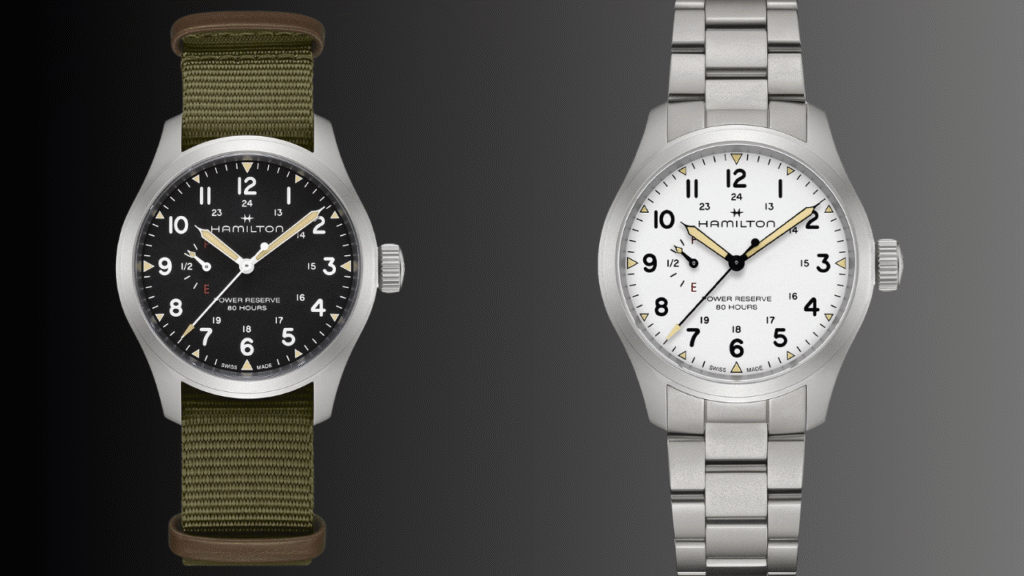The Hamilton Khaki Field collection is one of the pillars of the brand, a direct descendant of the rugged, reliable timepieces produced for the military throughout the 20th century. The foundation of this enduring legend lies in a profound military history that dates back to World War I. During that conflict, Hamilton provided “trench watches” that served as the initial template for the modern field watch, setting the stage for its central role in future military endeavors. This heritage was cemented during World War II when the brand demonstrated its unwavering commitment to the war effort by halting all consumer production to focus exclusively on timepieces for the U.S. armed forces. In this period, Hamilton produced more than one million watches and marine chronometers, an achievement that earned the company the prestigious U.S. Navy’s “E” award for manufacturing excellence. This period of focused production not only supported the Allied victory but also imbued the Hamilton name with a reputation for unmatched precision and innovation under duress.

Following the war, the purpose of field watches underwent a significant transition. The timepieces worn by returning service members were not just tools; they were symbols of their experience and service. Recognizing this enduring appeal, Hamilton shrewdly leveraged its military legacy to introduce mass-market models under the “Khaki” name. The Khaki Field watch, first launched in the 1960s, quickly became an icon for civilians and military personnel alike, embodying the philosophy of a “go-anywhere, do-anything” (GADA) watch. This post-war evolution successfully bridged the gap between military-grade functionality and civilian utility, cementing the Khaki Field’s status as a timeless and versatile timepiece that seamlessly blends authenticity with performance. The collection’s straightforward functionality, robust construction, and earthy color palettes are direct nods to this storied heritage, ensuring its continued popularity among both enthusiasts and casual wearers.
The New Khaki Field Power Reserve: A Dialectic of Old and New

For 2025, Hamilton has introduced a significant evolution to its celebrated Khaki Field line with the Khaki Field Power Reserve Mechanical 40mm. This new model is a masterclass in blending historical reverence with modern utility, beginning with its case. The 40mm diameter represents a deliberate and strategic choice, addressing a specific market demand. While the standard Khaki Field Mechanical has traditionally been offered in a smaller 38mm or a larger 42mm size, the 40mm dimension fills a crucial gap for collectors who prefer a versatile, mid-sized watch with a substantial wrist presence. This demonstrates Hamilton’s responsiveness to contemporary preferences while honoring the collection’s core aesthetic.
The sandblasted stainless steel case finish is a key design element that speaks to the watch’s tool-like character. This surface treatment, created by propelling tiny abrasive particles onto the metal, results in a textured, matte appearance that stands out from more common polished or brushed finishes. This choice serves a vital functional purpose: the non-reflective surface reduces glare, enhancing legibility in bright, outdoor conditions, a critical requirement for any true field watch. Beyond its functional utility, the sandblasted finish is also highly practical for the modern wearer. Unlike a polished surface that can show every minor scratch, the textured finish is exceptionally adept at minimizing the appearance of daily wear and tear, helping the watch maintain its pristine look over time. This design decision perfectly aligns form with function, marrying historical military design tenets with a valuable, everyday benefit for the consumer.
The hands and dial markers are another area where the watch expertly merges old and new. They are coated with what the brand calls “Old Radium” Super-LumiNova, a compelling aesthetic choice that taps into the romance of vintage horology. It is essential to understand that this pigment is not, in fact, radioactive. The name is a nod to the genuine, and highly dangerous, radium paint used on vintage timepieces that would yellow or “patina” over decades. By using this modern, non-hazardous compound, Hamilton honors its heritage while providing a safe product for its customers and the workers who assemble it. However, the use of Super-LumiNova is not without its critics. Some enthusiasts feel that while it glows brightly after being charged with light, its luminosity fades relatively quickly over a few hours, unlike the perpetual glow of historical radium or modern tritium. This is a recognized trade-off in the watch community, yet for the vast majority of consumers, the superior safety of Super-LumiNova is an easy choice.

From a practical standpoint, the watch is equipped with a sapphire crystal with anti-reflective coating, a significant upgrade from the mineral glass found on many competitors. The water resistance is rated at 50m, which the brand correctly characterizes as “field-ready (not sea-ready)”. While not suited for diving, this rating provides more than enough protection for daily use and exposure to rain or splashes. The versatility of the watch is further enhanced by its strap options, which include a classic NATO textile strap or a three-row stainless steel bracelet with an EasyClick system that allows for tool-free strap changes, a thoughtful and convenient feature for the modern enthusiast.
Table 1: Hamilton Khaki Field Comparison Matrix
| Feature | New Power Reserve 40mm | Khaki Field Mechanical 38mm | Khaki Field Mechanical 42mm |
| Case Size | 40mm | 38mm | 42mm |
| Thickness | 11.95mm | 9.5mm | Not specified |
| Movement | Hamilton Calibre H-23 (Hand-Wound) | Hamilton Calibre H-50 (Hand-Wound) | Hamilton Calibre H-50 (Hand-Wound) |
| Power Reserve | 80 hours | Up to 80 hours | Up to 80 hours |
| Key Complication | Power Reserve Indicator | None | None |
| Crystal | Sapphire with AR coating | Sapphire | Sapphire |
| Water Resistance | 50m (5 bar) | 50m (5 bar) | 50m (5 bar) |
| Price (CHF) | CHF 765 (NATO), 845 (Bracelet) | Starting at CHF 550 | Starting at CHF 650 |
The Calibre H-23: Technical Innovation and Horological Pedigree
At the heart of the new Khaki Field Power Reserve lies the Hamilton Calibre H-23, a hand-wound movement developed by ETA exclusively for Hamilton. This movement represents a significant technical step forward, building on a foundation with deep roots in modern horology. It is based on the tried-and-tested ETA 2801-2, which is the hand-wound equivalent of the ubiquitous ETA 2824-2. The movement has undergone the so-called “Powermatic 80 evolution,” a set of modifications that dramatically improve its performance. The H-23’s lineage means it inherits the robust, reliable architecture of its predecessors while introducing key innovations to meet modern demands. It is worth noting that while some discussions surrounding certain Powermatic 80 movements have mentioned the use of plastic components, this has been specifically refuted for Hamilton’s movements. The H-23 is confirmed to have an all-metal escapement, ensuring its durability and long-term serviceability.
The most immediately apparent benefit of the H-23 is its impressive 80-hour power reserve. This is achieved through two main technical modifications. First, the movement incorporates a longer, but less elastic, mainspring. A longer spring allows more energy to be stored, directly increasing the time the watch can run on a single full wind. Second, the movement’s beat rate has been reduced from the standard 28,800 vibrations per hour (vph) to 21,600 vph. A lower beat rate means the balance wheel beats less frequently, requiring less energy per oscillation and thereby conserving the mainspring’s stored power. While a slower beat rate can theoretically impact a watch’s accuracy, this potential trade-off is masterfully compensated for by the H-23’s high-quality Nivachron hairspring and free-sprung balance.
The Nivachron balance spring is a key differentiator for the H-23. This titanium-based alloy was developed by Nivarox-FAR in collaboration with Audemars Piguet and represents a significant upgrade over traditional hairspring materials. The watch’s accuracy is its greatest vulnerability, and this is especially true when exposed to external forces. The Nivachron hairspring provides exceptional resistance to magnetic fields—boasting 10 to 20 times the resistance of its predecessor, Nivarox. This is a critical advantage for the modern wearer, given the ubiquity of magnetic fields in daily life from smartphones, laptops, and speakers, which can severely compromise a watch’s precision. The alloy also maintains stable performance despite temperature variations and shocks, ensuring more consistent and reliable timekeeping for the user. The ability of Hamilton, as a member of the Swatch Group, to leverage this cutting-edge research and integrate such an advanced component into a watch at this price point is a powerful competitive advantage.

Another engineering highlight of the H-23 movement is the slipping-spring differential mechanism. This friction-based system serves a dual purpose, addressing two common challenges with hand-wound movements and their complications. The mechanism can be understood through an analogy to a limited-slip differential in a vehicle. In an automobile, this differential prevents a single wheel from losing traction and transfers torque to the wheel with grip. Similarly, in the H-23, the slipping spring uses friction to manage the energy flow, providing both overwind protection and synchronization for the power reserve indicator. For a hand-wound watch, a slipping spring in the mainspring barrel eliminates the “hard stop” that occurs when the movement is fully wound. This is a crucial user-friendly feature that prevents the wearer from accidentally overwinding the watch and damaging its delicate components. Concurrently, this mechanism ensures that the power reserve display remains perfectly synchronized with the mainspring’s state. It automatically resynchronizes the indicator during winding, ensuring that even if the hand is jostled by a shock, it will return to accurately reflect the remaining power.5 This demonstrates genuine high-end horological engineering brought to an accessible price point.
Table 2: Technical Breakdown: Hamilton Calibre H-23
| Feature | Technical Details |
| Base Caliber | Powermatic 80 (based on ETA 2801-2) |
| Movement Type | Hand-Wound Mechanical |
| Beat Rate (vph) | 21,600 vph |
| Power Reserve | 80 hours |
| Hairspring Material | Nivachron™ (Titanium-based alloy) |
| Key Mechanisms | Slipping-Spring Differential Mechanism, Friction-Controlled Differential |
| Jewels | Not specified (Powermatic 80 typically has 23) |
| Exclusive Features | Exclusive ETA development for Hamilton |
A Contender in a Crowded Field: Market Positioning and Competitive Analysis

The new Hamilton Khaki Field Power Reserve is not just another field watch; it is a significant market release that redefines the value proposition for its category. Its core differentiator is the inclusion of a power reserve indicator—a complication traditionally found on watches that are priced significantly higher, often in the luxury, five-figure range. By integrating this feature into a robust, hand-wound field watch at a price point under EUR 1,000, Hamilton is democratizing a high-end horological function. This positions the watch as a unique and compelling offering for enthusiasts who value both heritage and technical sophistication without an exorbitant price tag.
To fully appreciate its standing, a comparison with its key rivals in the field watch segment is essential. A common and much more affordable alternative is the Timex Expedition North Mechanical. While the Timex also features a sapphire crystal and a strong 100m water resistance, it utilizes a Chinese mechanical movement and lacks the Hamilton’s deep-rooted Swiss-American heritage and refined technical features. For consumers focused purely on affordability and function, the Timex is a strong contender, but it does not compete with the Hamilton’s elevated engineering or brand prestige.
Another compelling rival is the Bulova Hack, which shares a similar World War II heritage. The Bulova Hack offers an automatic movement and a compact, 38mm case, but it comes with certain trade-offs. It is thicker than the Hamilton’s 38mm model and has a less scratch-resistant mineral glass crystal and a more modest 30m water resistance. The Bulova is framed as a more affordable, automatic alternative, but the Hamilton provides a different experience with its hand-wound movement and technically superior features.
The Seiko 5 Sports field watch series represents the classic budget alternative. Seiko’s offerings provide a robust, in-house movement at a fraction of the cost of the Hamilton, but with a less refined finish and often a lower power reserve. While Seiko offers exceptional value and heritage, the Hamilton’s movement and finishing place it in a higher tier of quality and technical sophistication.
A critical element that explains Hamilton’s ability to offer such a technically advanced product at an accessible price point is its position within the Swatch Group. Hamilton is a direct beneficiary of the conglomerate’s substantial research and development budget. The proprietary Calibre H-23 and the advanced Nivachron hairspring are exclusive to Swatch Group brands, including Hamilton. The Nivachron alloy, for example, was initially developed in collaboration with Audemars Piguet, a high-end luxury brand, but is now being leveraged across the conglomerate’s portfolio. This strategic advantage gives Hamilton access to cutting-edge technology that independent brands or competitors simply cannot match, solidifying its position as a leader in delivering best-in-class value.
Table 3: Competitive Analysis Matrix: Hamilton vs. The Field
| Watch Model | Price (USD) | Movement Type | Power Reserve | Crystal Material | Water Resistance | Heritage/Key Feature |
| Hamilton Khaki Field Power Reserve | $945 – $1,025 | Hand-Wound Mechanical | 80 hours | Sapphire | 50m | Power Reserve Complication, Nivachron Hairspring |
| Timex Expedition North Mechanical | ~$229 | Mechanical (Chinese) | Not specified | Sapphire | 100m | Affordability, Strong Water Resistance |
| Bulova Hack | ~$319 | Automatic | Not specified | Mineral Glass | 30m | WWII Heritage, Affordable Automatic Movement |
| Seiko 5 SRPG31 | ~$275 | Automatic | 41 hours | Hardlex | 100m | In-house Movement, Robustness |
Final Thoughts

The Hamilton Khaki Field Power Reserve Mechanical 40mm is more than a simple product release; it is a strategic and well-executed evolution of an iconic watch. The analysis reveals a timepiece that masterfully synthesizes its storied military history with genuine, forward-looking technical innovation. Its core strength lies in its ability to offer a sophisticated, high-end complication—the power reserve indicator—at a remarkably accessible price point, democratizing a feature that has traditionally been the exclusive domain of luxury brands.
The new model successfully respects its heritage through its functional design cues, such as the legible dial and the rugged sandblasted finish, while embracing modern materials and engineering. The Calibre H-23, with its 80-hour power reserve and advanced Nivachron hairspring, is a testament to Hamilton’s ability to leverage its place within the Swatch Group to deliver cutting-edge performance. The inclusion of the slipping-spring differential mechanism not only protects the watch from overwinding but also ensures the power reserve display’s accuracy, demonstrating a level of technical consideration rarely seen in this price category.
This watch is ideally suited for the enthusiast who values a tactile, hand-wound experience and appreciates the tactile reassurance of winding their timepiece. It is for those who demand modern performance and convenience, but who also desire a watch with an authentic, well-documented history. The Hamilton Khaki Field Power Reserve Mechanical 40mm is a compelling package that represents a significant and worthwhile investment, solidifying Hamilton’s place as a leader in the accessible Swiss watch market and setting a new benchmark for what a field watch can be.